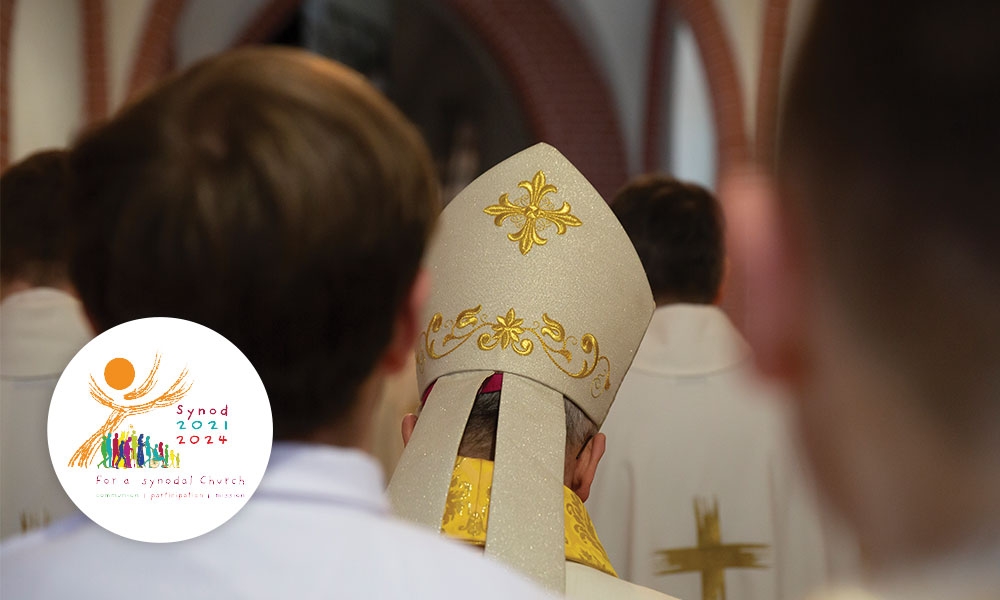
Becoming a synodal Church in mission
The final meeting of the Synod on Synodality, which began in 2021, will occur in October 2024 with the 2nd session of the Synod of Bishops. This session, which will again include laypeople and religious in addition to bishops, will continue the process of listening and dialogue that began in October 2023.
The guiding document for the upcoming assembly, called the Instrumentum Laboris, discusses the synodal journey thus far and moves to how to implement some of its aims by focusing on one specific question: How to be a synodal Church in mission? The 30-page document is divided into three sections, summarized briefly below:
The final meeting of the Synod on Synodality, which began in 2021, will occur in October 2024 with the 2nd session of the Synod of Bishops. This session, which will again include laypeople and religious in addition to bishops, will continue the process of listening and dialogue that began in October 2023.
The guiding document for the upcoming assembly, called the Instrumentum Laboris, discusses the synodal journey thus far and moves to how to implement some of its aims by focusing on one specific question: How to be a synodal Church in mission? The 30-page document is divided into three sections, summarized briefly below:
Part 1: Relationships
According to the first section, the Church must focus on nurturing relationships with God and within society. It is through these relationships that faith is transmitted. This section:
- Recognizes that Christian initiation offers a lens through which to understand the synodal life of the Church.
- Stresses the importance of baptism as the source of the call to mission for every Christian and the source of missionary fruitfulness.
- Articulates that baptized persons are given gifts of grace meant to be exercised in daily life and used in the service of others.
- Recommends investigation into structures of support for bishops and priests. This could include extending more responsibilities to laypeople, such as increased lay involvement in financial decision-making at the parish level and stronger parish councils.
- Calls for solidarity between local churches. This solidarity is brought about by an exchange of gifts: some local churches can offer material support; others can provide the witness of service to the poor; and others can offer the service of evangelization.
Part 2: Paths
The second section describes four “paths” or processes intended to cultivate and strengthen relations with God, within the Church and within society.
- Formation: Necessary for all the baptized so they can become effective witnesses of the Gospel.
- Discernment: Involves relying on the guidance of the Holy Spirit in journeying together. Requires listening to God as he speaks through his Word, the liturgy, the Church, events, the natural world and individual conscience. Also requires prayerful dialogue with each other –“Conversation in the Spirit.”
- Participatory decision-making: The hierarchical structure of the Church places decision-making responsibilities in the hands of the College of Bishops and the Roman Pontiff, but there is a place (and a need) for a consultative process. Synodal decision-making leads to “a shared decision in obedience to the Holy Spirit.”
- Transparency, accountability and evaluation: Especially important to recover these because of recent scandals. Local churches and dioceses are best suited to develop their own methods.
Part 3: Places
The Church’s life and mission have always been rooted in concrete contexts and places, but a “place” can no longer be understood in purely geographical and spatial terms. The third section of the document discusses the Church’s encounters with modern social and cultural conditions and the missionary activity possible within these new contexts.
- The Church must confront difficulties of urbanization, increased human mobility and digital culture. Relationships that facilitate the Church’s mission will no longer develop only in purely geographical contexts (such as a parish which has definite physical boundaries in a city), but in diverse and multifaceted networks and relationships.
- The aim of pastoral action “is to encounter every man and woman” in all contexts.
- The Bishop of Rome is the principle of unity and guarantor of synodality.
What’s Next?
Following the October meeting, the implementation phase of the synod will begin. This final phase is intended to “initiate the reception of the Synod’s conclusions in all the local Churches.”


